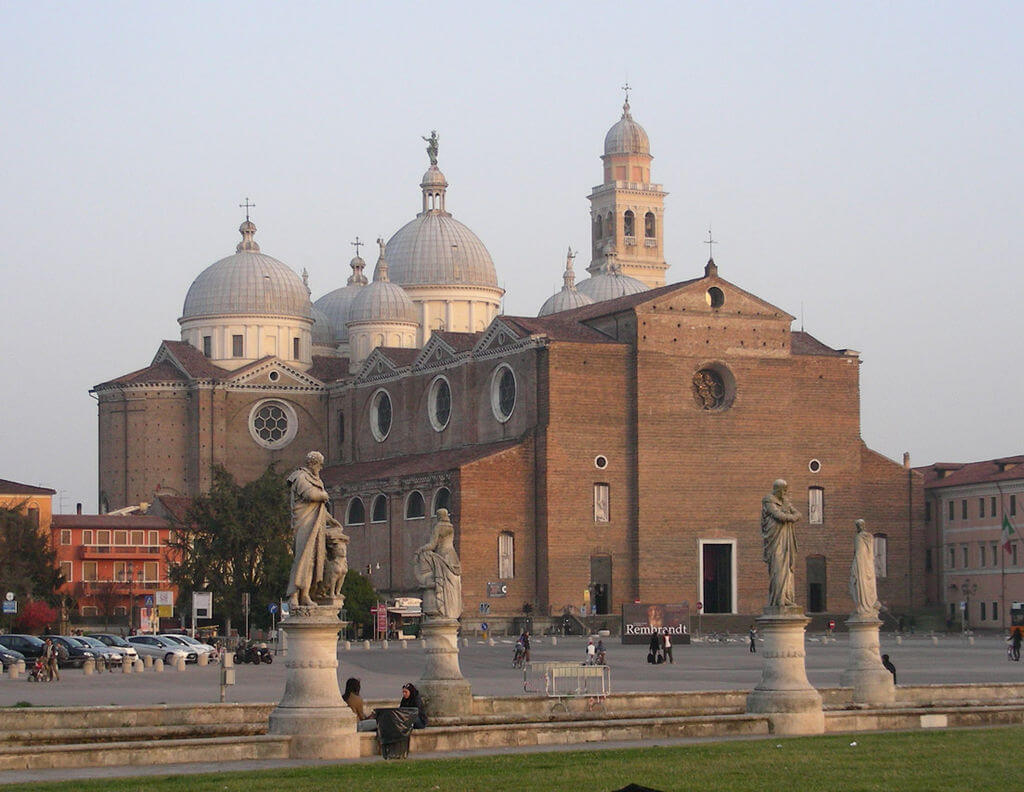Basilica di Santa Giustina
 Chiese
Chiese
Descrizione
La Basilica Abbaziale di Santa Giustina è un importante luogo di culto cattolico di Padova, situato in Prato della Valle.
Prima del 1000, l'annesso monastero fu luogo di culto da prima dipendenza episcopale e poi fu affidato ad una comunità di monaci benedettini che ne fecero un'importante abbazia. Nel XV secolo fu sede della grande riforma dell'abate Ludovico Barbo che portò alla fondazione della Congregazione cassinese. Sino alle soppressioni napoleoniche fu una della maggiori abbazie della cristianità e la basilica, ricostruita nel XVI secolo, è tuttora uno degli edifici più grandi del mondo. L'intero complesso è proprietà dello Stato italiano. Al suo interno, oltre alle celebri opere di Paolo Veronese, Sebastiano Ricci e della famiglia Corbarelli, si venerano le reliquie insigni dei santi Innocenti, san Luca evangelista, san Mattia apostolo, san Prosdocimo, santa Felicita, san Giuliano, sant'Urio, beato Arnaldo da Limena, san Massimo e della santa titolare, Giustina.
L'edificio si innalza su una pianta a croce latina che si estende da levante a ponente. Con i suoi 118,5 m di lunghezza e 82 m di larghezza, la basilica di Santa Giustina è una delle più grandi della cristianità. Settima in Italia per lunghezza dopo San Giovanni in Laterano, era la chiesa più grande dello Stato della Serenissima Repubblica. L'imponenza dell'edificio si misura con il grandioso invaso del Prato della Valle, su cui si affaccia.
Sorte nell'ordine composito, le tre principali cappelle, che sono il presbiterio col coro, e le due dei santi Luca e Mattia che formano il transetto della basilica, concludono entrambe a semicircolo e sono affiancate da due cappelle ciascuna concluse sempre con abside semicircolare. Lungo le navate, si aprono dodici cappelle minori a pianta quadra, sei per parte. I 26 grandiosi pilastri sostengono la copertura a cupole prive di tamburo, volte a botte e la complessità della crociera illuminata da otto cupole coperte a piombo: quella centrale, con la lanterna, è alta quasi 70 m ed è sovrastata dalla statua di rame, rivolta alla città, raffigurante Santa Giustina, alta circa 5 m. La 4 cupole circondanti la centrale presentano anch' esse sulla propria sommità statue metalliche di vari santi: Prosdocimo, Benedetto, Daniele e il Beato Arnaldo. Gli 8 semicatini della crocera e i 3 catini sul soffitto della navata centrale, senza però provocare cupole all' esterno del tetto, che resta a capanna, furono eretti su suggerimento di Vincenzo Scamozzi verso il 1605 per rendere perfetta l'acustica dell'edificio. E queste ultime 3 calotte interne presentano un'altezza diversa fra loro e digradante mano a mano che ci si allontana dall'altar maggiore in direzione della contro facciata.
Il pavimento della basilica fu gettato tra il 1608 e il 1615 su disegno geometrico, con marmo giallo, blu e rosso in una resa di effetto straordinario e caleidoscopico. Vi sono pure molti brani di marmo greco, proveniente dalla basilica opilionea.
La facciata, incompiuta, si innalza su un crepidoma che porta ai 3 portali chiusi da moderni battenti bronzei. Sulle ruvide pareti si aprono un grande rosone ed alcune più piccole aperture, più quattro nicchie vuote su cui sono state collocate, in occasione del Giubileo del 2000, altorilievi raffiguranti gli Evangelisti. Per la facciata in passato erano state proposte più soluzioni di compimento: le ultime furono quelle di Giuseppe Jappelli.
Fonte: Wikipedia
The Abbey of Santa Giustina is a Benedictine abbey in the center of the City of Padua, facing the Prato della Valle, which dates from the 10th century. The abbey is attached to the Basilica of Santa Giustina, which was built in the 6th century. Its present shape derives from construction in the 17th century.
The abbey is attached to the basilica which was built in the 520s by the Prefect Opilius to house the remains of St. Justina of Padua (d. 7 October 304) and of other Christian martyrs of the city. The building, with its lavish decorations, was described in 565 in a Life of St. Martin written by Venantius Fortunatus. By the 10th century, the presence of a monastic community which served the many pilgrims who came to the basilica to pray to the saints whose relics were contained there is seen in the decision of the Bishop of Padua in 971 to place the community under the Rule of St. Benedict.
At that point the monastic community undertook renovations of the basilica. In the course of this work, on 2 August 1052 the remains of various saints, including Maximus the Confessor, Felicitas of Padua, Julian the Hospitaller and those identified as the Holy Innocents, were exhumed. In 1110 the abbey was sacked by the troops of the future Holy Roman Emperor Henry V during his invasion of Lombardy, in order to punish the monks for their loyalty to Pope Pascal II. The basilica complex was devastated in 1117 by a massive earthquake which wreaked havoc throughout northern Italy and Germany. After the basilica and monastery were rebuilt, excavations resumed and in 1174 the remains of the patroness of the abbey was discovered, as were those identified in 1177 as those of Luke the Evangelist.
A period of decline in the observance of its way of life began to develop in the monastic community. At the same time, the monks were led by a number of very spiritual abbots, such as Arnaldo of Limena, who died while imprisoned by Ezzelino III da Romano and is honored as "Blessed", as is Nicholas of Prussia. The abbey, however, reached the height of its influence under the leadership of Ludovico Barbo, who, despite being a canon regular and not a monk, was appointed as abbot by the bishop in order to undertake a reform of the monastic life in the abbey. He was successful and the abbey became the nucleus of the Congregation of Santa Giustina, which spread to include monasteries throughout Europe who came under the guidance of the Abbot of Santa Giustina. The congregation later became called the Cassinese Congregation. The abbey developed ties with centers of learning across the continent.
The life of the abbey came to an end in 1797 when, along with all other religious communities, it was suppressed in the occupation of Italy by the French Revolutionary Army, led by Napoleon Bonaparte, which established the Cisalpine Republic in the city. Its artworks and the most valuable collections of the abbatial library were sent to Paris by the occupying forces. The monks were expelled and the buildings and property were sold off in 1810. The cloisters were then used as a military hospital, later as a barracks.
Credits: Wikipedia

